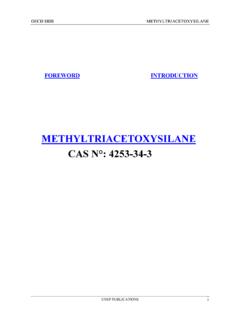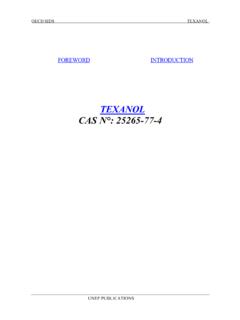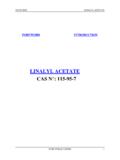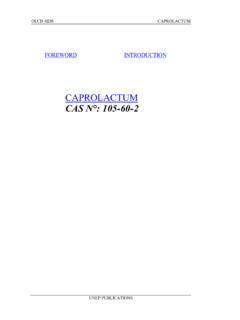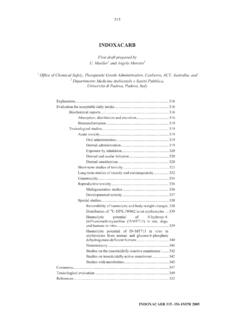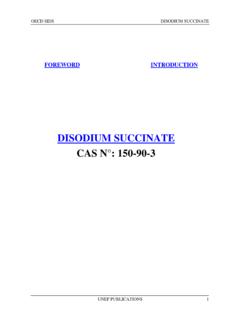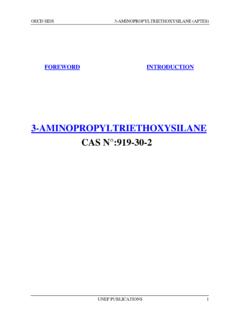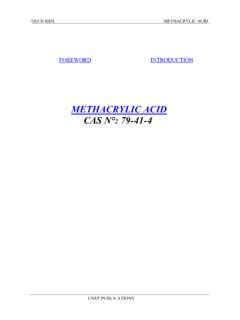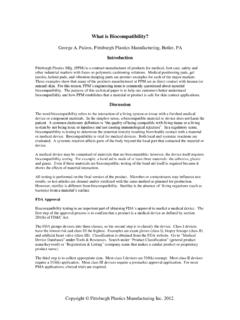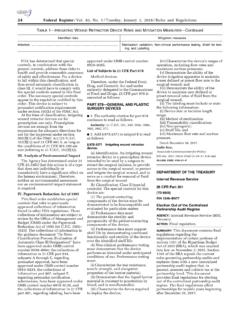Transcription of MONO- AND DISUBSTITUTED METHYLTIN, …
1 This report contains the collective views of an international group of experts and does not necessarily represent the decisions or the stated policy of the United Nations Environment Programme, the International Labour Organization, or the World Health Organization. Concise International Chemical Assessment Document 73 MONO- AND DISUBSTITUTED methyltin , butyltin , and octyltin COMPOUNDS First draft prepared by Stuart Dobson and Paul D. Howe, Centre for Ecology & Hydrology, Monks Wood, Huntingdon, Cambridgeshire, United Kingdom; and Peter Floyd, Risk & Policy Analysts Limited, Loddon, Norfolk, United Kingdom Published under the joint sponsorship of the United Nations Environment Programme, the International Labour Organization, and the World Health Organization, and produced within the framework of the Inter-Organization Programme for the Sound Management of Chemicals. The International Programme on Chemical Safety (IPCS), established in 1980, is a joint venture of the United Nations Environment Programme (UNEP), the International Labour Organization (ILO), and the World Health Organization (WHO).
2 The overall objectives of the IPCS are to establish the scientific basis for assessment of the risk to human health and the environment from exposure to chemicals, through interna-tional peer review processes, as a prerequisite for the promotion of chemical safety, and to provide technical assistance in strengthening national capacities for the sound management of chemicals. The Inter-Organization Programme for the Sound Management of Chemicals (IOMC) was established in 1995 by UNEP, ILO, the Food and Agriculture Organization of the United Nations, WHO, the United Nations Industrial Development Organization, the United Nations Institute for Training and Research, and the Organisation for Economic Co-operation and Development (Participating Organizations), following recommendations made by the 1992 UN Conference on Environment and Development to streng-then cooperation and increase coordination in the field of chemical safety.
3 The purpose of the IOMC is to promote coordination of the policies and activities pursued by the Participating Organizations, jointly or separately, to achieve the sound management of chemicals in relation to human health and the environment. WHO Library Cataloguing-in-Publication Data Mono- and DISUBSTITUTED methyltin , butyltin , and octyltin compounds. (Concise international chemical assessment document ; 73) First draft prepared by Stuart Dobson, Paul D. Howe and Peter Floyd. compounds - adverse effects. compounds - toxicity. exposure. assessment. , Stuart. , Paul D. III. Floyd, Peter. Health Organization. Programme on Chemical Safety. ISBN 92 4 153073 1 (NLM classification: QV 290) ISBN 978 92 4 153073 6 ISSN 1020-6167 World Health Organization 2006 All rights reserved. Publications of the World Health Organization can be obtained from WHO Press, World Health Organization, 20 Avenue Appia, 1211 Geneva 27, Switzerland (tel: +41 22 791 3264; fax: +41 22 791 4857; e-mail: Requests for permission to reproduce or translate WHO publications whether for sale or for noncommercial distribution should be addressed to WHO Press, at the above address (fax: +41 22 791 4806; e-mail: The designations employed and the presentation of the material in this publication do not imply the expression of any opinion whatsoever on the part of the World Health Organization concerning the legal status of any country, territory, city or area or of its authorities, or concerning the delimitation of its frontiers or boundaries.))
4 Dotted lines on maps represent approximate border lines for which there may not yet be full agreement. The mention of specific companies or of certain manufacturers products does not imply that they are endorsed or recommended by the World Health Organization in preference to others of a similar nature that are not mentioned. Errors and omissions excepted, the names of proprietary products are distinguished by initial capital letters. All reasonable precautions have been taken by WHO to verify the information contained in this publication. However, the published material is being distributed without warranty of any kind, either express or implied. The responsibility for the interpretation and use of the material lies with the reader. In no event shall the World Health Organization be liable for damages arising from its use. The named authors alone are responsible for the views expressed in this publication.
5 Risk assessment activities of the International Programme on Chemical Safety, including the production of Concise International Chemical Assessment Documents, are supported financially by the Department of Health and Department for Environment, Food & Rural Affairs, United Kingdom; Environmental Protection Agency, Food and Drug Administration, and National Institute of Environmental Health Sciences, USA; European Commission; German Federal Ministry of Environment, Nature Conservation and Nuclear Safety; Health Canada; Japanese Ministry of Health, Labour and Welfare; and Swiss Agency for Environment, Forests and Landscape. Technically and linguistically edited by Marla Sheffer, Ottawa, Canada, and printed by Wissenchaftliche Verlagsgesellschaft mbH, Stuttgart, Germany iii TABLE OF CONTENTS FOREWORD ..1 1. EXECUTIVE SUMMARY ..4 2. IDENTITY AND PHYSICAL/CHEMICAL PROPERTIES.
6 6 3. ANALYTICAL METHODS ..7 4. SOURCES OF HUMAN AND ENVIRONMENTAL EXPOSURE ..8 Use of mono- and DISUBSTITUTED organotins in PVC ..9 Use of mono- and DISUBSTITUTED organotins as catalysts ..10 Electrodeposition ..10 Silicones ..10 Esterification and powder coating ..11 Polyurethanes ..12 Use of monobutyltin trichloride in glass 5. ENVIRONMENTAL TRANSPORT, DISTRIBUTION, AND TRANSFORMATION ..12 6. ENVIRONMENTAL LEVELS AND HUMAN EXPOSURE ..14 Environmental levels ..14 Measured concentrations ..14 Estimation of PECs ..17 Human exposure ..18 7. COMPARATIVE KINETICS AND METABOLISM IN LABORATORY ANIMALS AND HUMANS ..18 8. EFFECTS ON LABORATORY MAMMALS AND IN VITRO TEST SYSTEMS ..21 Single Irritation and sensitization.
7 21 Short- and medium-term Neurotoxicity ..23 Reproductive and developmental toxicity ..23 Immunotoxicity ..25 Endocrine disruption ..27 Long-term exposure and Genotoxicity and related end-points ..27 Other toxicities ..32 Mode of 9. EFFECTS ON HUMANS ..32 10. EFFECTS ON OTHER ORGANISMS IN THE LABORATORY AND FIELD ..33 Aquatic Terrestrial environment ..33 Concise International Chemical Assessment Document 73 iv iv11. EFFECTS Evaluation of health effects ..33 Hazard identification and dose response assessment ..33 Criteria for setting tolerable intakes and tolerable Sample risk characterization ..38 Evaluation of environmental Hazard identification.
8 41 Derivation of PNECs in fresh water ..41 Derivation of PNECs for marine Risk characterization ..42 Uncertainties in the risk characterization ..42 12. PREVIOUS EVALUATIONS BY IOMC BODIES ..43 APPENDIX 1 ACRONYMS AND ABBREVIATIONS ..52 APPENDIX 2 SOURCE DOCUMENT ..53 APPENDIX 3 CICAD PEER APPENDIX 4 CICAD FINAL REVIEW BOARD ..54 INTERNATIONAL CHEMICAL SAFETY CARDS ..55 R SUM D ORIENTATION ..59 RESUMEN DE ORIENTACI Mono- and DISUBSTITUTED methyltin , butyltin , and octyltin compounds 1 FOREWORD Concise International Chemical Assessment Documents (CICADs) are published by the International Programme on Chemical Safety (IPCS) a cooperative programme of the World Health Organization (WHO), the International Labour Organization (ILO), and the United Nations Environment Programme (UNEP). CICADs have been developed from the Environmental Health Criteria documents (EHCs), more than 200 of which have been published since 1976 as authoritative documents on the risk assessment of chemicals.
9 International Chemical Safety Cards on the relevant chemical(s) are attached at the end of the CICAD, to provide the reader with concise information on the protection of human health and on emergency action. They are produced in a separate peer-reviewed procedure at IPCS. They may be complemented by information from IPCS Poison Information Monographs (PIM), similarly produced separately from the CICAD process. CICADs are concise documents that provide sum-maries of the relevant scientific information concerning the potential effects of chemicals upon human health and/or the environment. They are usually based on selected national or regional evaluation documents or on existing EHCs. Before acceptance for publication as CICADs by IPCS, these documents undergo extensive peer review by internationally selected experts to ensure their completeness, accuracy in the way in which the original data are represented, and the validity of the conclusions drawn.
10 The primary objective of CICADs is characteri-zation of hazard and dose response from exposure to a chemical. CICADs are not a summary of all available data on a particular chemical; rather, they include only that information considered critical for characterization of the risk posed by the chemical. The critical studies are, however, presented in sufficient detail to support the conclusions drawn. For additional information, the reader should consult the identified source documents upon which the CICAD has been based. Risks to human health and the environment will vary considerably depending upon the type and extent of exposure. Responsible authorities are strongly encour-aged to characterize risk on the basis of locally measured or predicted exposure scenarios. To assist the reader, examples of exposure estimation and risk characteriza-tion are provided in CICADs, whenever possible. These examples cannot be considered as representing all possible exposure situations, but are provided as guidance only.
